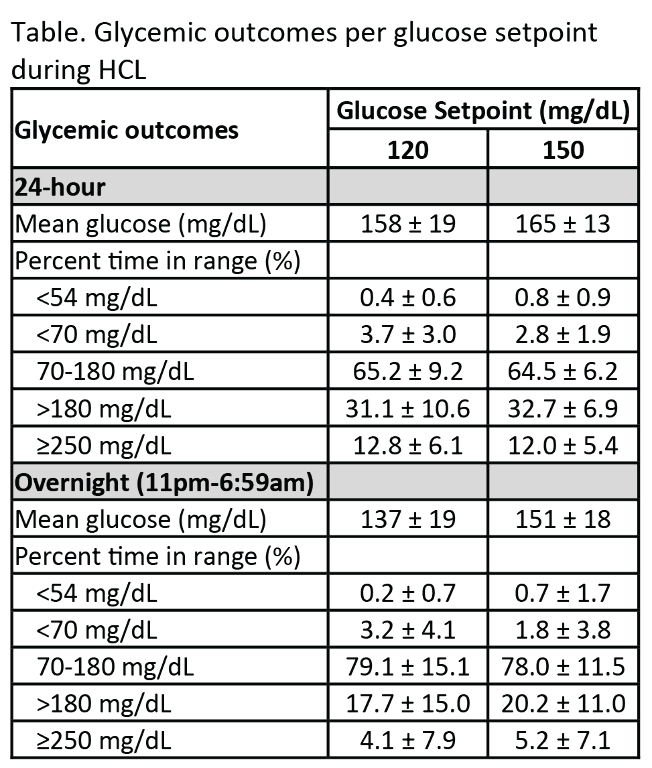Jennifer Sherr, United States of America
Moderator of 1 Session
Presenter of 3 Presentations
PERFORMANCE OF OMNIPOD PERSONALIZED MODEL PREDICTIVE CONTROL ALGORITHM WITH MULTIPLE SETPOINTS AND MEAL AND EXERCISE CHALLENGES IN CHILDREN AGED 2-12 YEARS WITH TYPE 1 DIABETES
- Jennifer Sherr, United States of America
- Bruce A. Buckingham, United States of America
- Gregory P. Forlenza, United States of America
- Alfonso Galderisi, United States of America
- Laya Ekhlaspour, United States of America
- R. Paul Wadwa, United States of America
- Melinda Zgorski, United States of America
- Ryan Kingman, United States of America
- Cari Berget, United States of America
- Joon Bok Lee, United States of America
- Jason O’connor, United States of America
- Bonnie Dumais, United States of America
- Todd Vienneau, United States of America
- Lauren Huyett, United States of America
- Trang Ly, United States of America
Abstract
Background and Aims
The Omnipod hybrid closed-loop (HCL) personalized model predictive control (MPC) algorithm was assessed in children aged 2-12y with type 1 diabetes (T1D) using an investigational device. This study provided the first evaluation at multiple glucose setpoints and with missed meal boluses in this age group.
Methods
Participants aged 2-12y with T1D and A1C<10.0% using CSII or MDI were eligible for a 72-96-h HCL study conducted in a supervised free-living hotel setting. At HCL start, the glucose setpoint was 150mg/dL, and at 24-48h it was lowered to 120mg/dL. The system was stress-tested with 1-2 missed lunch boluses, high fat dinners, and daily moderate-intensity exercise. Endpoints were mean glucose and percentage time <54, <70, 70-180, >180, and ≥250mg/dL at each setpoint.
Results
Participants (n=9) were (mean±SD): age 7.1±2.2y, T1D duration 3.0±1.6y, and A1C 7.6±1.0%. Glycemic outcomes at each setpoint are reported in the Table. Despite stress-testing the system with missed meal bolus challenges (20-75g carbohydrate) and exercise, percentage time in target range (TIR) from 70-180 mg/dL was ~65% regardless of the system setpoint. Mean glucose was 158±19mg/dL and 165±13mg/dL at the 120mg/dL and 150mg/dL setpoints, respectively.
Conclusions
The Omnipod personalized MPC algorithm performed well and was safe for up to 5 days of use in children aged 2-12y with T1D when stress-tested at 2 different setpoints under challenging conditions. With recent consensus guidelines recommending TIR >60% for youth, our data demonstrate the feasibility of attaining this goal despite the challenges imposed in this trial.

Pramlintide and Metformin in type 1 diabetes
Abstract
Background and Aims / Part 1
Application of adjunctive therapies for treatment of type 1 diabetes (T1D) has been an area of intense exploration. However, prior to the recent approval of the dual SGLT1/2 inhibitor in Europe, the sole therapy approved for those with T1D had been pramlintide. Garnering approval from the FDA in 2005, pramlintide has had limited penetrance into clinical practice, potentially due to the need for multiple daily subcutaneous injections to administer it. To overcome this issue, some have explored co-formulation of pramlintide with insulin analogues. This presentation will review the mechanism of action of pramlintide, studies describing its use in those with T1D, and examine how co-formulation has altered the potential to integrate this therapy, even in automated insulin delivery systems.
Methods / Part 2
Additionally, the role of metformin in treatment of T1D will also be reviewed focusing on the mechanism of action, studies of the agent in those with T1D, with particular focus on its effects on long-term risk of cardiovascular disease.
Nasal glucagon: a novel rescue option for severe hypoglycemia
Abstract
Background and Aims / Part 1
For many years, treatment of severe hypoglycemia has remained relatively stagnant requiring use of a multistep, injection kit in order to administer glucagon. This complex task to be orchestrated during a stressful time was prone to error, or even the decision to forgo treatment. Thus, alternate glucagon formulations have been explored, with nasal glucagon administration first being assessed in the 1980s. Over the past decade, studies of nasal glucagon have gone from rigorous inpatient trials to outpatient assessments with real-world application of the product. This presentation will review these trials, as well as simulation studies and provide updates regarding use of nasal glucagon as it has become commercially available.
